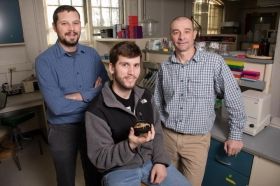As far as anyone can tell, the cold-water crayfish Faxonius eupunctus makes its home in a 30-mile stretch of the Eleven Point River and nowhere else in the world. According to a new study, the animal is most abundant in the middle part its range, a rocky expanse in southern Missouri – with up to 35,000 cubic feet of chilly Ozark river water flowing by each second.
As far as anyone can tell, the cold-water crayfish Faxonius eupunctus makes its home in a 30-mile stretch of the Eleven Point River and nowhere else in the world. According to a new study, the animal is most abundant in the middle part its range, a rocky expanse in southern Missouri – with up to 35,000 cubic feet of chilly Ozark river water flowing by each second.
Because the crayfish is so rare, environmental authorities are considering listing F. eupunctus as an endangered species. But doing so requires a thorough accounting of its population size and distribution. To achieve this, researchers at the Illinois Natural History Survey at the University of Illinois used both old-school techniques and newer, high-tech methods.
“The traditional way to find crayfishes in this type of river is a method called kick-seining,” said graduate research assistant Christopher Rice, who conducted the study with Christopher Taylor, the INHS curator of fishes and crustaceans, and Eric Larson, a U. of I. professor of natural resources and environmental sciences. The INHS is a division of the Prairie Research Institute at the U. of I.
“You take a mesh seine attached to two poles and stand out in the stream, and someone else kicks rocks and flushes water and crayfishes down into the net,” Rice said. Once caught, the animals can be counted, measured and sexed – all valuable data for those hoping to conserve them. In the new study, the team kick-seined a dozen 1-square-meter plots at each of 39 sites along the river and in several smaller tributaries feeding it.
Read more at University of Illinois at Urbana-Champaign
Image: From left, natural resources and environmental sciences professor Eric Larson, graduate research assistant Christopher Rice and INHS curator of fishes and crustaceans Christopher Taylor used old-school methods and newer techniques to study a rare crayfish. (Credit: L. Brian Stauffer)




